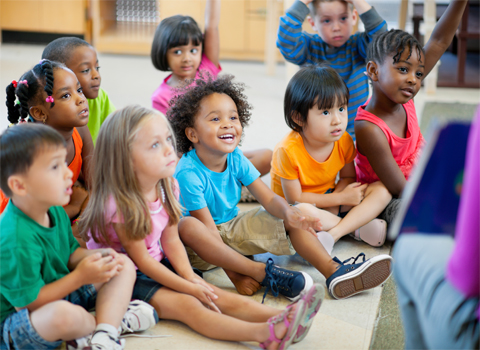Use of Storytelling and Interactive Play with Kindergarteners
Kindergarteners are true explorers. They are curious, eager to learn, and they thrive on discovering new things through interactive exploration. Their language skills and imagination are growing immensely—they love stories.
I saw this in action one day in a kindergarten class at a Christian school in downtown Chicago. The class hummed with activity and conversation as the kindergarteners moved through various workstations with writing, math, language, science, and Bible stories. A timer was used to track the allotted time periods. When the bell rang, each group of children moved to the next station. I was merely a fly on the wall—an observer.
At the Bible story station, I watched one little girl select a box with figurines, props, and squares of felt. The box was labeled “Peter Walks on Water.” She pulled out the simple props and began retelling (to two other children) how Peter walked across the water to Jesus. Her sound effects, details, and simple dialogue between Jesus and Peter held their attention. Then the next child picked up the box and told the story again, using her own variation and ideas—still staying true to the story. Soon the bell rang and a new batch of children came to that station.
What a wonderful idea to involve children! I thought to myself. I resolved to try this on my class of Kindergarteners on Sunday. I wanted to find as many creative ways as possible to engage my Kindergarteners in telling and retelling the narratives they were learning. I put together a prop-kit that matched the upcoming Bible story. Cottons balls became sheep, blocks became a fence, and a generic figurine became a shepherd. Green felt became grass, a strip of blue cloth the still water, and a black plastic bag depicted the “valley of the shadow of death.” Step by step, I told the story of Psalm 23 and then later provided time for the kids to chose activities—one of which was retelling the Bible story. The children’s versions often included more sound effects than mine—but the main points and plotlines were accurate. I was encouraged!
Here are more creative ideas to incorporate storytelling and interactive play into your classroom:
- Act out the Bible Story together. Retell the Bible story told earlier by acting. Select character roles and then have fun dramatizing the narrative. You will probably want to narrate the story initially, and then invite another capable student to take the lead before you move to another station. Be available if students need help remembering major plotlines and details.
- Make Storytelling Kits for Review: Make “prop-kits” for the upcoming character stories and narratives in your lessons. Each week, gather various figurines, fabrics, props, or animals that will help retell the Bible story. You can use felt figures and storyboard, wooden figurines and props, or even paper cutouts on Popsicle sticks. You will be surprised what the children will remember!
- Create a Puppet Station: Your children would enjoy watching puppets who act out the lesson. Create simple puppets the kids can use, or allow them to use the “official” puppets if yours are easy to damage.
- Encourage Imaginative Storytelling: During free-play periods, mentoring time, or as a parent at home, invite your child to make up stories with various characters and settings. Incorporate friends, animals, playgrounds, travel, or normal life routines. Ask them to include God in the story. The role that the child assigns to God and how He acts will alert you to his or her view of the Lord. Use the story to spark conversation about who God is!
- Facility Role-plays of Life Lessons: Use drama to help teach helpful social skills. As your year progresses and your students get to know each other, you will observe each child’s struggles. Your students will vary in their ability to respect each other’s physical space, possessions, or feelings. Role-play these social skills. Give an example role-play and then have the children “practice” how they would share, speak, or act towards their friends in the scenario you present.
Discipleship Begins With Our Children
Children need meaningful, shared-life relationships. That’s the heart of discipleship. DiscipleLand’s family of Biblical resources forms a complete Children’s Discipleship System™ – an intentional, relational, and transformational process designed to help children know God intimately, love Him passionately, and to serve Him selflessly. Click here for your Free Catalog
Learn more by clicking on the following:
• Samples
• Nursery and Toddler
• Preschool
• Kindergarten
• Elementary
• Kids Church
• Midweek
• Free Catalog






